Abstract
1. Eating, drinking and spontaneous motor activity were studied in rats receiving large daily doses of morphine. These forms of behaviour were largely suppressed when the rats were made abstinent and were restored when morphine was given again.
2. Compensation for depressions of behaviour during abstinence did not seem sufficient to account for all the stimulant effects of morphine in tolerant rats. Morphine also had slight stimulant actions in non-tolerant rats.
3. In tolerant rats, the repeated pairing of the effects of morphine with the re-emergence of behaviour such as eating and drinking may intensify the rewarding value of the drug.
Full text
PDF



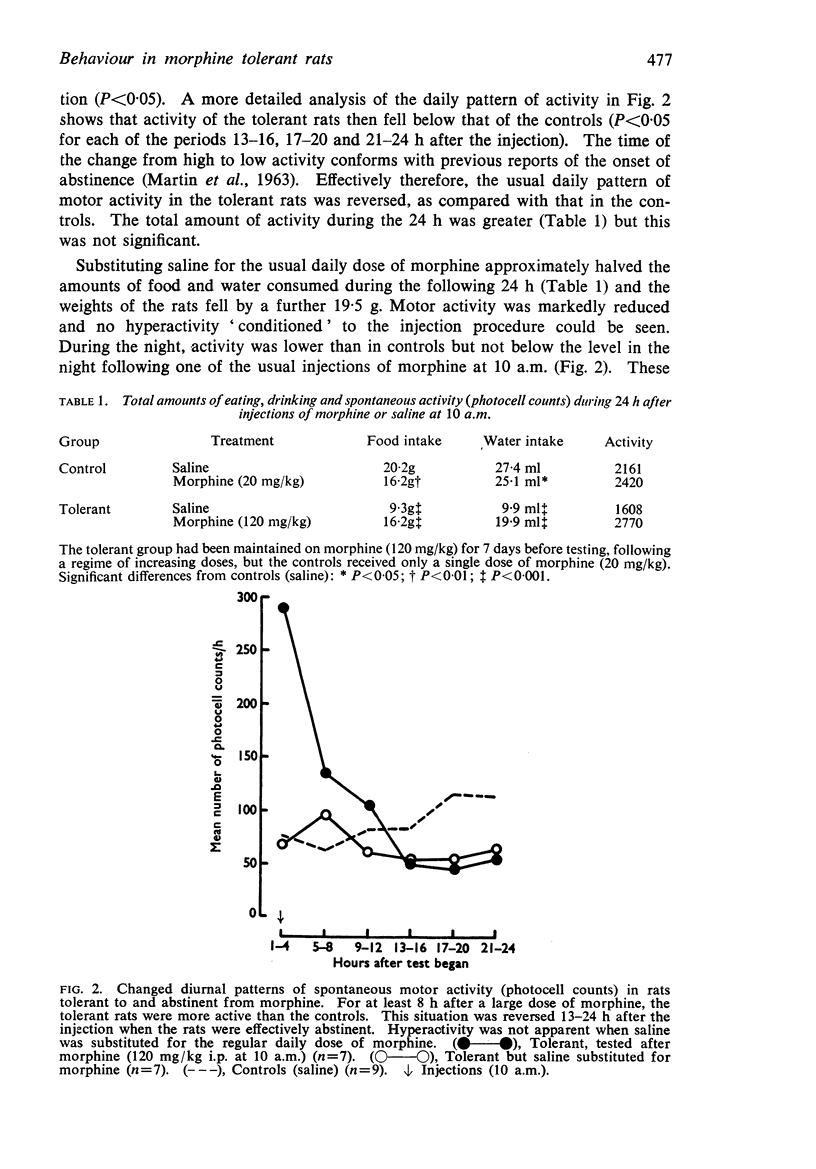
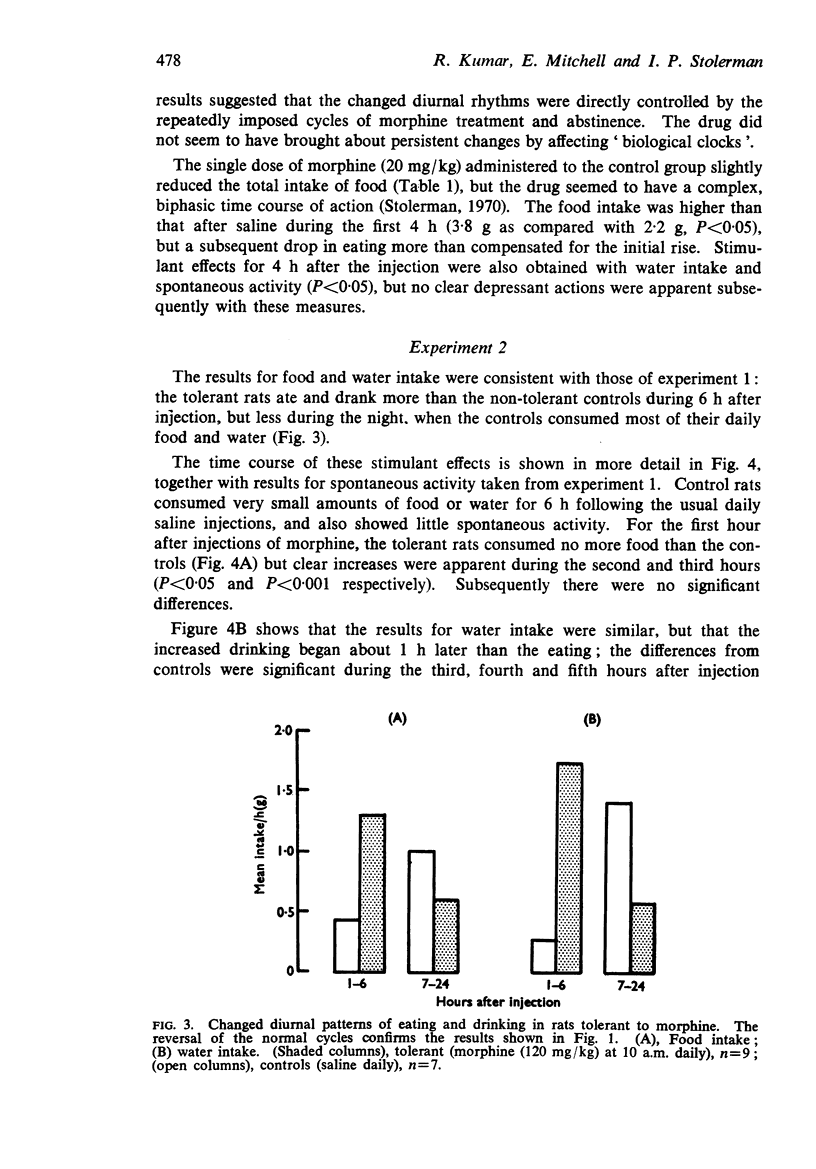
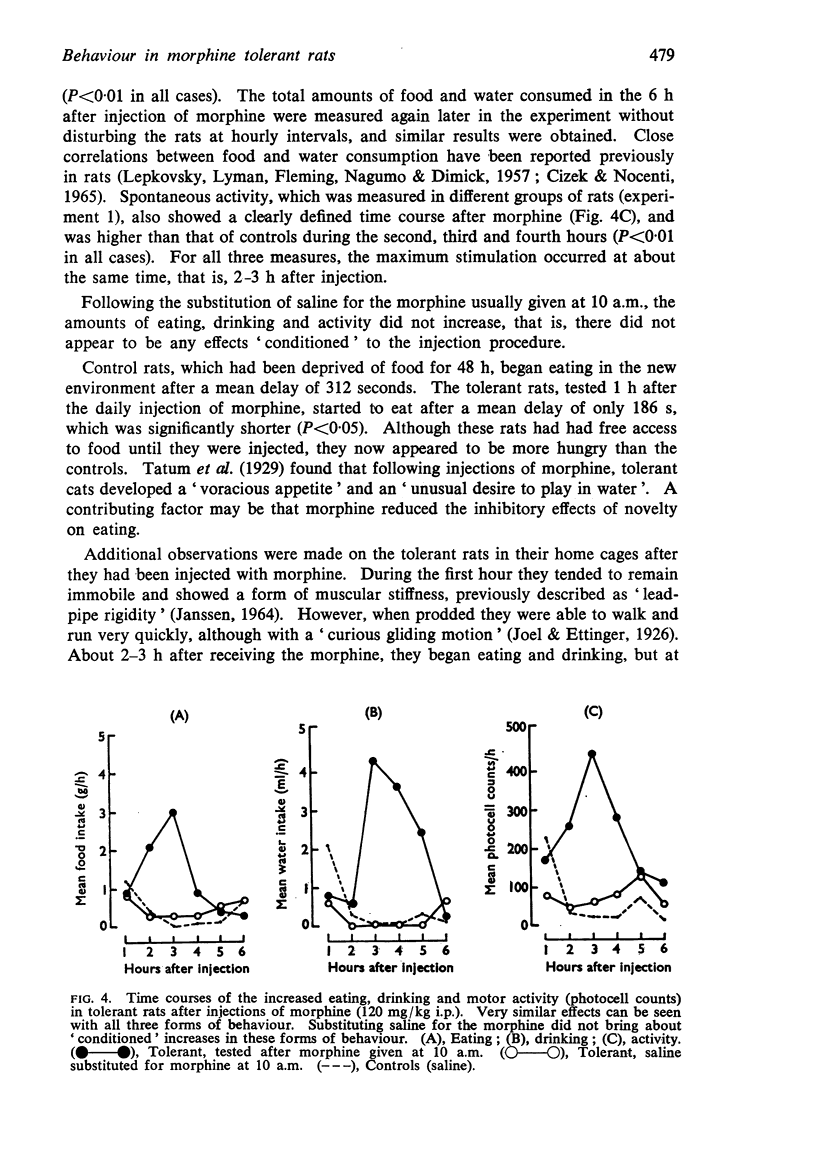
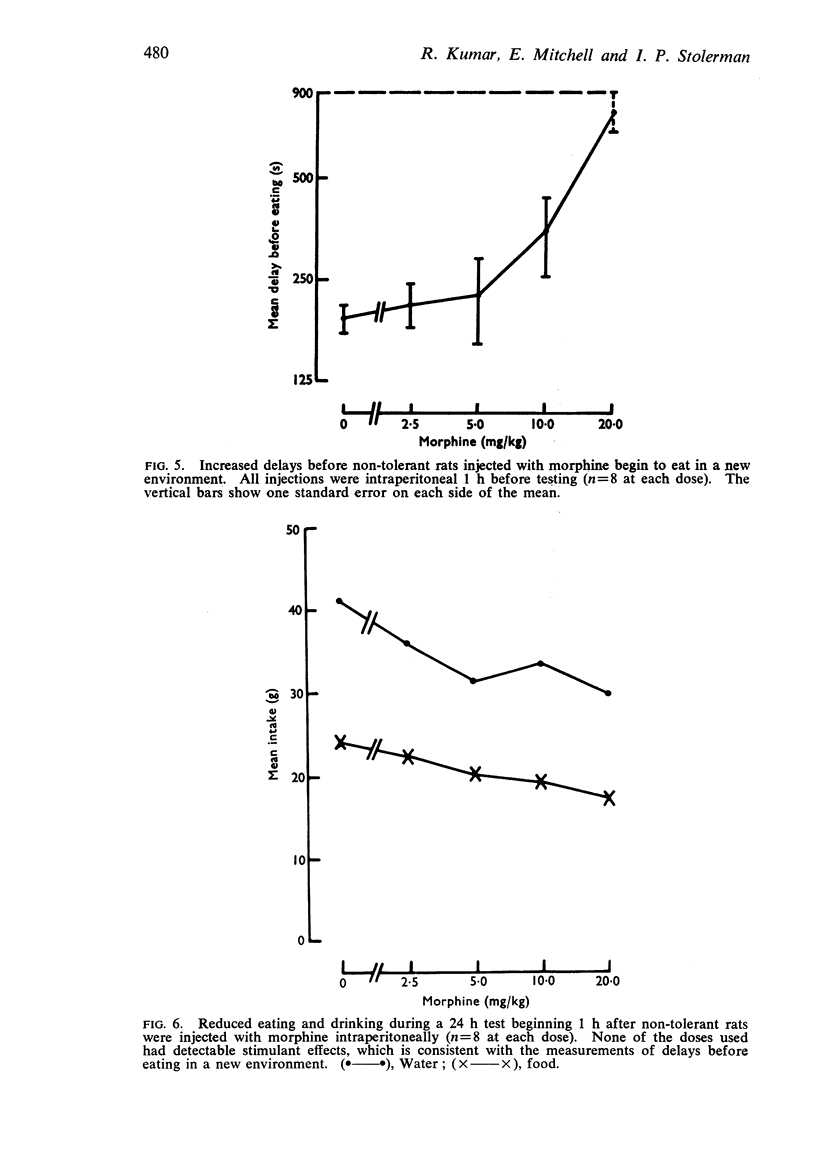


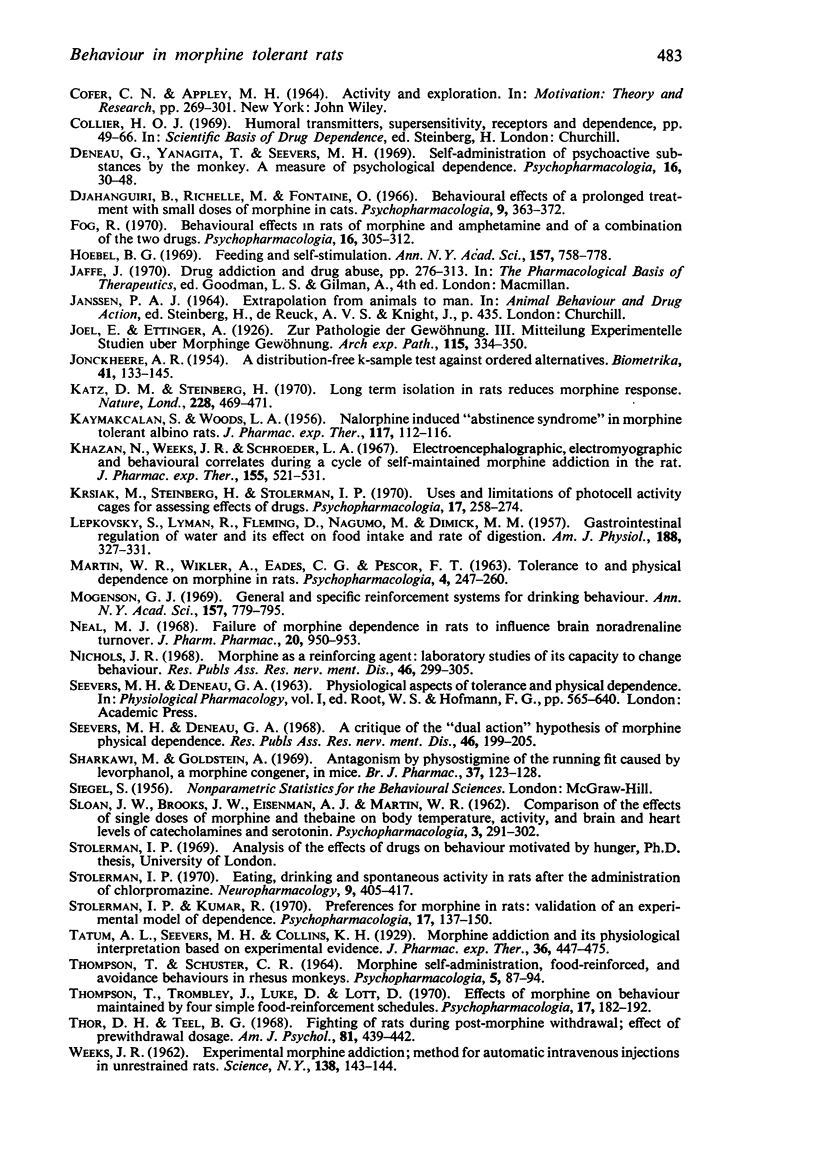
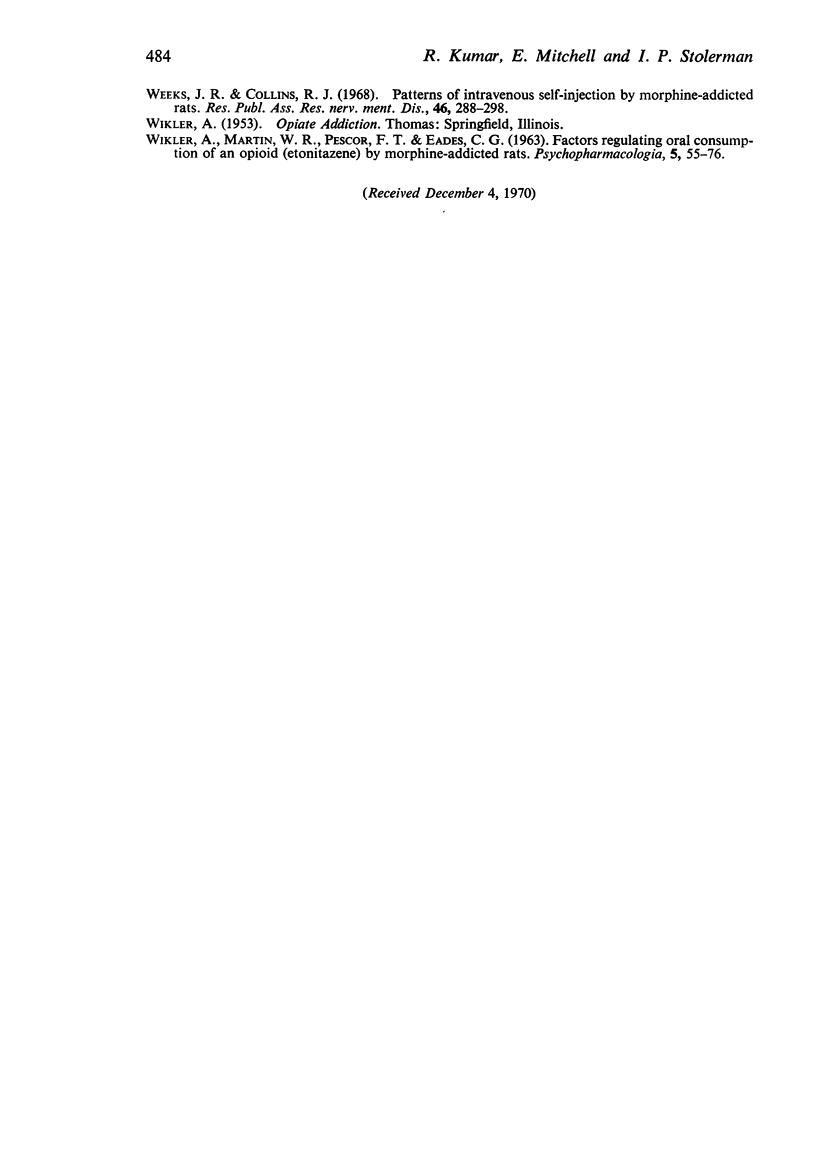
Selected References
These references are in PubMed. This may not be the complete list of references from this article.
- Akera T., Brody T. M. The addiction cycle to narcotics in the rat and its relation to catecholamines. Biochem Pharmacol. 1968 May;17(5):675–688. doi: 10.1016/0006-2952(68)90004-x. [DOI] [PubMed] [Google Scholar]
- BOLLES R. C. READINESS TO EAT: EFFECTS OF AGE, SEX, AND WEIGHT LOSS. J Comp Physiol Psychol. 1965 Aug;60:88–92. doi: 10.1037/h0022319. [DOI] [PubMed] [Google Scholar]
- CIZEK L. J., NOCENTI M. R. RELATIONSHIP BETWEEN WATER AND FOOD INGESTION IN THE RAT. Am J Physiol. 1965 Apr;208:615–620. doi: 10.1152/ajplegacy.1965.208.4.615. [DOI] [PubMed] [Google Scholar]
- Deneau G., Yanagita T., Seevers M. H. Self-administration of psychoactive substances by the monkey. Psychopharmacologia. 1969;16(1):30–48. doi: 10.1007/BF00405254. [DOI] [PubMed] [Google Scholar]
- Djahanguiri B., Richelle M., Fontaine O. Behavioural effects of a prolonged treatment with small doses of morphine in cats. Psychopharmacologia. 1966;9(5):363–372. doi: 10.1007/BF00406447. [DOI] [PubMed] [Google Scholar]
- Fog R. Behavioural effects in rats of morphine and amphetamine and of a combination of the two drugs. Psychopharmacologia. 1970;16(4):305–312. doi: 10.1007/BF00404736. [DOI] [PubMed] [Google Scholar]
- Hoebel B. G. Feeding and self-stimulation. Ann N Y Acad Sci. 1969 May 15;157(2):758–778. doi: 10.1111/j.1749-6632.1969.tb12919.x. [DOI] [PubMed] [Google Scholar]
- KAYMAKCALAN S., WOODS L. A. Nalorphine-induced abstinence syndrome in morphine-tolerant albino rats. J Pharmacol Exp Ther. 1956 May;117(1):112–116. [PubMed] [Google Scholar]
- Katz D. M., Steinberg H. Long-term isolation in rats reduces morphine response. Nature. 1970 Oct 31;228(5270):469–471. doi: 10.1038/228469a0. [DOI] [PubMed] [Google Scholar]
- Khazan K., Weeks J. R., Schroeder L. A. Electroencephalographic, electromyographic and behavioral correlates during a cycle of selfmaintained morphine addiction in the rat. J Pharmacol Exp Ther. 1967 Mar;155(3):521–531. [PubMed] [Google Scholar]
- Krsiak M., Steinberg H., Stolerman I. P. Uses and limitations of photocell activity cages for assessing effects of drugs. Psychopharmacologia. 1970;17(3):258–274. doi: 10.1007/BF00402085. [DOI] [PubMed] [Google Scholar]
- LEPKOVSKY S., LYMAN R., FLEMING D., NAGUMO M., DIMICK M. M. Gastrointestinal regulation of water and its effect on food intake and rate of digestion. Am J Physiol. 1957 Feb;188(2):327–331. doi: 10.1152/ajplegacy.1957.188.2.327. [DOI] [PubMed] [Google Scholar]
- MARTIN W. R., WIKLER A., EADES C. G., PESCOR F. T. TOLERANCE TO AND PHYSICAL DEPENDENCE ON MORPHINE IN RATS. Psychopharmacologia. 1963 May 21;4:247–260. doi: 10.1007/BF00408180. [DOI] [PubMed] [Google Scholar]
- Mogenson G. J. General and specific reinforcement systems for drinking behavior. Ann N Y Acad Sci. 1969 May 15;157(2):779–797. doi: 10.1111/j.1749-6632.1969.tb12920.x. [DOI] [PubMed] [Google Scholar]
- Neal M. J. Failure of morphine dependence in rats to influence brain noradrenaline turnover. J Pharm Pharmacol. 1968 Dec;20(12):950–953. doi: 10.1111/j.2042-7158.1968.tb09681.x. [DOI] [PubMed] [Google Scholar]
- Nichols J. R. 23. Morphine as a reinforcing agent: laboratory studies of its capacity to change behavior. Res Publ Assoc Res Nerv Ment Dis. 1968;46:299–310. [PubMed] [Google Scholar]
- SLOAN J. W., BROOKS J. W., EISENMAN A. J., MARTIN W. R. Comparison of the effects of single doses of morphine and thebaine on body temperature, activity, and brain and heart levels of catecholamines and serotonin. Psychopharmacologia. 1962 Oct 5;3:291–301. doi: 10.1007/BF00411369. [DOI] [PubMed] [Google Scholar]
- Seevers M. H., Deneau G. A. XV. A critique of the "dual action" hypothesis of morphine physical dependence. Res Publ Assoc Res Nerv Ment Dis. 1968;46:199–205. [PubMed] [Google Scholar]
- Sharkawi M., Goldstein A. Antagonism by physostigmine of the "running fit" caused by levorphanol, a morphine congener, in mice. Br J Pharmacol. 1969 Sep;37(1):123–128. doi: 10.1111/j.1476-5381.1969.tb09529.x. [DOI] [PMC free article] [PubMed] [Google Scholar]
- Stolerman I. P. Eating, drinking and spontaneous activity in rats after the administration of chlorpromazine. Neuropharmacology. 1970 Sep;9(5):405–417. doi: 10.1016/0028-3908(70)90013-4. [DOI] [PubMed] [Google Scholar]
- Stolerman I. P., Kumar R. Preferences for morphine in rats: validation of an experimental model of dependence. Psychopharmacologia. 1970;17(2):137–150. doi: 10.1007/BF00402704. [DOI] [PubMed] [Google Scholar]
- THOMPSON T., SCHUSTER C. R. MORPHINE SELF-ADMINISTRATION, FOOD-REINFORCED, AND AVOIDANCE BEHAVIORS IN RHESUS MONKEYS. Psychopharmacologia. 1964 Jan 7;5:87–94. doi: 10.1007/BF00413045. [DOI] [PubMed] [Google Scholar]
- Thompson T., Trombley J., Luke D., Lott D. Effects of morphine on behavior maintained by four simple food-reinforcement schedules. Psychopharmacologia. 1970;17(2):182–192. doi: 10.1007/BF00402708. [DOI] [PubMed] [Google Scholar]
- Thor D. H., Teel B. G. Fighting of rats during post-morphine withdrawal: effect of prewithdrawal dosage. Am J Psychol. 1968 Sep;81(3):439–442. [PubMed] [Google Scholar]
- WEEKS J. R. Experimental morphine addiction: method for automatic intravenous injections in unrestrained rats. Science. 1962 Oct 12;138(3537):143–144. doi: 10.1126/science.138.3537.143. [DOI] [PubMed] [Google Scholar]
- WIKLER A., MARTIN W. R., PESCOR F. T., EADES C. G. FACTORS REGULATING ORAL CONSUMPTION OF AN OPIOID (ETONITAZENE) BY MORPHINE-ADDICTED RATS. Psychopharmacologia. 1963 Oct 24;5:55–76. doi: 10.1007/BF00405575. [DOI] [PubMed] [Google Scholar]
- Weeks J. R., Collins R. J. XXII. Patterns of intravenous self-injection by morphine-addicted rats. Res Publ Assoc Res Nerv Ment Dis. 1968;46:288–298. [PubMed] [Google Scholar]


